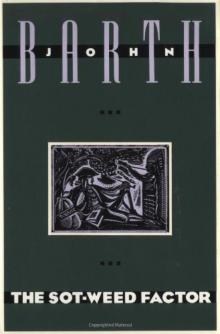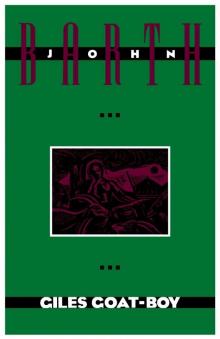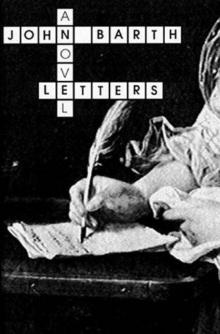- Home
- John Barth
The Tidewater Tales Page 2
The Tidewater Tales Read online
Page 2
Here’s how.
SET ME A TASK!
As Kathy Sherritt will tell it next fall, when we’re home in Baltimore and she’s back at work as Director of Folklore and Oral History at the Enoch Pratt Free Library, The Tidewater Tales: A Novel saw daylight at about six p.m. during Blooey! along with the other things she gave birth to that remarkable evening aboard Story, at anchor with the weekend fleet aswarm behind Ordinary Point, up near the cervix of Chesapeake Bay. But it was conceived just prior to Blam! two weeks before at Nopoint Point, the Sherritt spread on Goldsborough Creek, off the Tred Avon, off the Choptank, off that same Chesapeake, farther down that Eastern Shore, when pent-up Peter Sagamore, that Kathy’s best friend, best lover, best husband, moderately celebrated author of short and shorter stories, and father of the whole kaboodle in her womb, cried For pity’s sake, Kathy, set me a task!—thereby setting her one.
NOPOINT POINT
A lover’s task is what Peter meant: something he could do to demonstrate to Katherine Sherritt that he loves her like life and language themselves despite mosquitoes, heat, humidity, her parents’ trying unsuccessfully not to be a bother, precious little sex since Kath’s on the cusp, no tennis but brutal with macho male Sherritts all save Andy the youngest of whom blow him off the family court in straight sets, every day less swimming in Sherritt Cove, less windsurfing and waterskiing out in Goldsborough Creek, because on each new tide the sea nettles move a bit farther in like a billion old condoms with their miserable sting and beautiful name, Chrysaora quinquecirrha, which means five-filamented gold-edge but ought to mean God’s five-month curse upon the Talbot County Gold Coast, no respite from Kathy’s old prep-school and college chums, family friends, and fellow ASPS (American Society for the Preservation of Storytelling), swarming like sheepflies on Nopoint Point, including her onetime (one time) lesbian lover, a black-belt balladeer and sometime pain in our marital tush, though Kathy won’t hear May Jump spoken ill of except by Peter in extremis. And more.
Now, P welcomes these diversions for good K’s sake, but so much company gets to a chap who, while no solitary, is a duetary unabashedly and for sure: Give him him and Kathy Sherritt; the rest of the world is just . . . material. And on the bottom line—by reason of these manifold irritations and distractions and the low-grade, high-level suspense of when for pity’s sake will she unload, and what and how many . . . Well.
To be sure, it’s been no picnic for Katherine Shorter Sherritt, these two weeks on Nopoint Point; P.S. knows that. She loves the man as does he her and is as grateful for his uncomplaint as is he hers, but she’s the one with the fabulous bellyful, Estimated Date of Confinement two weeks hence by our best reckoning: 29 June ‘80, 266 nights since a certain blessed one last fall—though inasmuch as all such EDCs are ± two weeks, she might just unload here in mid-sentence and set him a task indeed. She’s the one hors de combat, on maternity leave from the great Pratt’s Word of Mouth Department; from supervising oral history projects through the neighborhood branches, collecting urban folklore and recording immigrant folktales out of Baltimore’s ethnic smorgasbord; from telling apprentice-level tales under May Jump’s ongoing tutelage to the very young and very old and the blind and the unlettered, working toward her brown belt in recitation; from conducting seminars in otolaryngeal narrative and taking them in narration; from assuming the wheel herself sometimes of the Inner City Talemobile in winter or one of the Storycycles in summer to carry forth the word from Cathedral Street as well as bring it back; and in general from looking after the library’s Office of Oral Input as May (once upon a time) looked after its Out-. She misses that. A writer may be his own best company: Desert Island or Manhattan Island, for Peter Sagamore it’s scratch and scribble, scribble and scratch. But a mouth needs an ear, an ear a mouth; Kath’s as gregarious as Pete’s egregious; it’s mainly the human flow through Nopoint Point, with its freight of anecdote and inquiry, that has eased the tedium of this fortnight in the First Guest Cottage. Bored out of her skull is Katie, by enforced inactivity and unresponsibility; as gratefully surfeited as Peter with her parents’ benevolent overkill; weary as he of making more shift than love, and on top of all straining her lumbars to haul who knew how many of who could say what, given that equivocal ultrasound scan, from poolside to courtside to dockside to dinnertableside to husbandside at last in bed.
P. Sagamore has been since early May on summer leave from professing the Art of Everdiminishing Fiction, and will be till September. Now’s when he normally does the most of his raw inventing for the year, which then through the academic season he’ll fret and tinker at, buff and burnish, trim and tighten and tighten and trim as he preaches to beginners and coaches his advanced apprentices at the state university’s main campus down in College Park, until by spring each item glows with the Sagamore shine that’s made his name. Eight or six tiny items, apparently artless but hard and luminous, as if the idlest objects on your desk or outside your window, the homeliest gestures of ordinary people, were composed, compressed, and caused to shine each with its own refulgence, a mysterious, sharp limpidity. Though nowise obscure or difficult, Peter’s art is without pizzazz, and ever terser. The cognoscenti cheer; the larger public, regrettably, ignores him, and, regretfully, he them.
The month of May normally gets our man into high gear and happy fits of abbreviation: His teaching’s done, but Kathy’s still at work; our Baltimore apartment he has all to himself from half past eight to half past five. Four hours of making long notes for short paragraphs; an hour of lunch and mail; two of sweet mindless physicality in some nearby school’s gymnasium or on its tennis court; another two of chores, odd jobs, and errands about beflowered Baltimore; two or three more of building and eating dinner with Katherine Shorter Sherritt, comparing days, conferring upon the wider world—our favorite time, which we do not rush: wine and candles every blessed weekday, Telemann on tape, good food and quiet talk till cleanup’s done at eight or nine; the balance of the evening reading, walking, letter-writing, very occasional movie-or theatergoing, perhaps with friends. Some okay restaurant weekly, some better one monthly, a semesterly party of some sort. To this routine add typically those two weeks in June of sailing on the Bay; now and then a quick winter ski trip or Caribbean beach-out when the cash flow flows. The occasional off-campus lecture junket for Peter or, for Katherine, library scientists’ convention. Twice in our decade together short visits to Europe, whither in our earlier decades apart Kathy Sherritt had gone often, briefly, and Peter Sagamore once for a corner-turning year.
Thus our life, reader, which we love. Thus, normally, our May. Come June, we’d normally close our Stony Run flat, spend a long weekend with the Sherritts at Nopoint Point commissioning and provisioning old Story and baffling Henry Sherritt once again with our preference for an engineless, unamenitied little sloop over Katydid IV, his fifty-foot ketch with three staterooms, two hot showers, full electronics, and a mighty diesel, which we’re welcome to use with or without the paid hand. After a happy fortnight’s sailing and drifting, back to steamy Baltimore and to work, returning most weekends to Nopoint Point, where there’s never not room aplenty.
A regular life and a tranquil; a privileged life and an easy. Yet a busy life, a productive—and a too too swiftly running. Normally.
This May, no; this June, no. Jack Bass, the family obstetrician-gynecologist, who delivered Katherine early in his practice, has half retired to a spread of his own across Goldsborough Creek, but is still sought after by Gold Coasties in the family way and supervises the pregnancies of those he once delivered. Kath’s is a case Doctor Jack has followed with more than routine interest: He delivered her first husband, Porter “Poonie” Baldwin, Jr., and shrugged his shoulders at that marriage, which all four parents cheered; he tisked his tongue at its early breakup and aborted young Mrs. Baldwin’s pregnancy back when abortion was not much done in Talbot County; he consoled Henry Sherritt on the golf course and prescribed Valium for Irma; he approved K’s subsequent pai
ring with Captain Fritz Sagamore’s son from across the broad Choptank, despite that family’s much lower social rank; he applauded our decision eight years later to get married and pregnant if P’s old vasectomy could be surgically reversed, and steered him to a Boston urologist whose specialty is iffy reanastomosis; he rejoiced with us at evidence of motile sperm, danced at our wedding, and coached our late-procreative efforts when success did not at once crown them; he toasted our eventual pregnancy and monitored its regrettable miscarriage; he counseled Kathy—who by then was thirty-eight and getting no younger—on our final long-shot strategy and cheered its clear payoff in early winter; he informed us in March that he heard two heartbeats in there, in April two at least, and ordered an ultrasound scan to clarify matters wombwise; then he put an arm about Peter Sagamore’s shoulders, took Kathy Sherritt’s hand in his, regarded with us in equal awe the wondrous video display of what looked like a sibling-incestuous, polymorphous-perverse prenatal orgy of Siamese septuplets, such was the tangle of shadowy arms and legs and umbilici flickering before us, and could or would not say further than that the delivery was definitely going to be multiple and that a week or two might be subtracted from our EDC. He recommended that Kath begin her maternity leave on the first of June instead of its ides and move to Nopoint Point for the entire summer, where he’d be five minutes away from the First Guest Cottage by Boston Whaler and no more than fifteen by Jaguar from either Chez Sherritt or Easton Memorial Hospital. Inasmuch as he knows us Sherritt-Sagamores to be great lookers-up and checkers-out of information, he felt constrained to forewarn us that morbidity and mortality rates increase for second-born twins, second-and third-born triplets, second-, third-, and fourth-born quadruplets, to say no further. Delivery by cesarean section was more than a possibility, despite our hopes to go the natural route.
WELL!
We remind ourselves now that we reminded ourselves then that going on and then off the Pill plus hitting the fertilizer improves the odds not only for conception (that was our half-year long shot), but for multiple conception. Given Kathy’s age, we told ourselves, and the seventy-percent lowered fertility rate of men with vasovasectomies, it is unlikely we’ll give pregnancy another go. Something to be said, in short, for putting all one’s eggs in this one basket, if one wants more than one.
But who wants? Though we both affirm that a child sans siblings is the poorer for that lack, we ourselves have each in fact one close to her/his heart, one not; it seems a toss-up. And even with Help, each privately sees—at the prospect of two (-plus) infants, two (-plus) preschoolers—our duetary peace and quiet, already but a dear memory since 1 June, receding that much farther into the future. Not till 1998, by Peter’s gloomy private reckoning, two years before the millennium, when he’ll be pushing sixty, will the kids be off to college and the apartment tranquil enough again for him to write—should world and colleges, himself and writing, survive so long. Broods Kathy to her glummest self Hah: quintuplets in a high-crime city low-rise? We’re in the housing market, Peter mio: the big housing market. With eleven-percent mortgages a bargain already and thirteen-percenters soon to be nostalgia, but real estate prices booming in the Baltimore-Washington corridor, you and I are going to have to buy a multibedroomed, play-basemented, fancy-kitchened, laundry-roomed, central-AC’d, automatic garage-doored, quiet low-crime side-streeted play-yarded azaleaed dogwooded magnoliaed suburban for Christ’s sake house!
As Hank and Irma Sherritt’s only daughter, Princess Kate growing up on Nopoint Point had two of everything including brothers, trikes, bikes, cars, mailing addresses, coming-out parties, rs and ts in her family name, and, in time, colleges, degrees, husbands, and uncompleted pregnancies. One day she’ll have the best of that again, compounded: her share of the old, abundant Sherritt pile. She’s glad of that, because she honors her parents and because there are at least three causes she looks forward to philanthropizing massively: her husband, who has paid his workaday dues and should be freed to give his remaining prime time, all of it, to his ever-terser art; her ASPS, of which she and May Jump are founding members; and her HOSCA (Hands Off South and Central America), an organization devoted to the frustration of U.S. meddling in the governments of its southern neighbors. But in the middle while between rich and rich—if only, she grants, like a person stepping coatless into the cold from a warm room to which she’ll presently return—she’s pleased to do with little in the ownership way, K, a good deal less than our twin salaries could afford: our light and airy but spare apartment; a modest wardrobe from Loehmann’s discountery and L. L. Bean’s mail-order outdoorsery, her chief indulgence. No car of her own; no television; art mostly from the Baltimore Museum’s rental gallery; tapes, records, and books on loan from the Pratt. It is marshy Hoopers Island Peter, public-high-school state-university Peter, who bought and treasures our secondhand BMW and thirdhand sailboat of his late father’s manufacture, the threadbare Herizes, Tabrizes, and Bokharas on our floors, the Japanese brush drawings and stereo, Scandinavian furniture and French food processor and German coffeemaker and cabinetful of okay Bordeaux. But until we can afford to commission some architect friend to design us a simple, high-tech, energy-efficient, unostentatious, unobtrusive little gem tucked into the trees on some high point of land on the Chester or the Sassafras, say, where we can swim naked in the natural element instead of suited up in the Sherritts’ filtered and chlorinated tank, he wants a house no more than she.
A house! And then, no doubt, pet animals; he sure loved his in boyhood days: the world of Kitty Litter, Hartz flea collars, fish tanks, gerbil cages. Are there Boy and Girl Scouts still? Merit badges? Peter Sagamore was born into a moderately poor family made poorer by the Great Depression in historically poor lower Dorchester County, Maryland; he grew up without benefit of baby-sitters, nursery schools, summer camps, special-education fast tracks, and pressure from his parents to excel, both of whom had gone to work at sixteen and were delighted to see their children finish South Dorchester High. Katherine Sherritt was born into a moderately rich family made richer by every declared war in U.S. history in historically rich Talbot County, Maryland; she too grew up without baby-sitters (the Sherritts had live-in nannies and governesses), without summer camps (the Sherritts spent their Augusts in Maine or Spain), without special-ed fast tracks (a Sherritt’s ed is special from prekindergarten on), without pressure from her parents to excel (the Sherritts have taken excellence in one form or another for granted since the eighteenth century). Having so much inexperience in common, we understandably share some apprehension about dealing with Pampers and PTAs, especially in triplicate or quadruplicate.
But we made up our minds two years ago, not impulsively, to join genes, and we’re not displeased with our success, only dismayed by its extent; Peter Sagamore especially. One child, small, was what he had in mind, by whose lights a windy sentence is one with more than two clauses or three commas; whose longest short story in recent years runs maybe six pages, his recenter ones three or two, his recentest—you’ll see. The world has things enough in it already; more than enough; too many. One ought ever to add to their number with reluctance. Pete’s Cartesian, Kath Rabelaisian. Sentences, paragraphs like these must be hers, under whose good breasts are lungs like a marathoner’s, a Met soprano’s. This green-belt raconteuse can recite Homer’s Catalogue of Ships or Gargantua’s of bumswipes at the clip of a Gilbert and Sullivan patter song and make you call not only Bravo but Encore. She can enjoy the Ocean City public beach and boardwalk on a July Fourth afternoon with a third of a million fellow humans schooled like smelts, or the common fitting room at Loehmann’s just before High Holidays, for which no simile will serve. If Less Is More is Pete, More Is More is Kath. Pete’s pet poet is Emily Dickinson: zero at the bone. Katherine Sherritt’s is Walt Whitman: I contain multitudes.
In sum, a well-coupled couple, and not only Jack Sprat-wise. At abundant Kathy’s core, her friend discovered years ago, like hurricane’s eye or black hole in a plenum, is a small bu
t central bubble not of nothing but of Nothingness: an empty point where some Big Bang must have banged, since from it her universe busies out in all directions, particularly his. Peter Sagamore’s life has been by contrast all but void of scenes, events, things, relations, distractions; son of monotonous marshes stretching sky to sky, he thrives upon silence, sparseness. But as in fact those wetlands teem and nurse the elsewise lifeless oceans, so at Peter’s center, his friend discovered years ago, is not only a wistful, detached affection for the variety and busyness of the world, but a certain hard tireless dedicated energy, like a quasar blazing X rays in the universe’s crawlspace. From that core his lean art radiates, as do by the way his attraction to and patience with the busy life of Nopoint Point, in measured doses, and his measureless delight in Katherine Sherritt.
DO THE WOMAN.
That won’t be easy from our coupled point of view—P’s promptings, K’s cadenzas—but she’ll draw a great breath; we’ll try. Here’s the woman of us, in her man’s opinion: Katherine Shorter Sherritt at thirty-nine is a rangy, long-limbed looker looking thirty-three tops and topped with beach-colored hair (both the dry beach and the wet), streaked straight past fine strong shoulders when she lets it down. She has Hank Sherritt’s Episcopalian bright gray eyes, Irma Shorter’s twenty-four-carat skin and cultured-pearl dentition. She’ll dress to the nines when occasion calls and sophisticate in three languages, Kate, but she’s easy in the preppie drag she wears to work: tweed skirts, cable-knit crewnecks over oxford-cloth buttondowns; easier yet in soft jeans and hiking boots and flannels, swapping stories with her ASPS across an Ozark campfire; easiest of all in the all-but-altogether with Peter Sagamore, spanking along in Story through a summer afternoon or splashing naked by moonlight with the noctilucae. When Katherine takes her clothes off later in this prologue and stands in the First Guest Cottage wearing only earrings, wedding band, and fine gold chain necklace, you’ll see those aforesung breasts engorged by pregnancy beyond their normal trim, their russet aureoles stretched cookie-size: athletical buttocks fairly firm even this far gone; smoothmuscled, fineskinned calves and thighs, flawless; and what was till the turn of the year a hard flat belly with God’s thumbprint for a navel. All this, mind, in her husband’s opinion (and May Jump’s). She’s an Outward Bound type, Kath: backpacker, white-water canoeist, distance swimmer. She’s a green-belt karatiste as well as raconteuse, don’t mess with K.S.S., though that belly’s thrown her balance off. Under all that skin she is intuitive but clearheaded, even hardheaded when necessary. She is memorious, practical, capable, Kathy, but more dependent than she wishes upon Peter’s stability and good humor to level out her swings from up to down to up. Life having been generous to her, she is in his opinion generous with hers: Much of that Pratt work is hardcore inner-city, and she is forever volunteering for good-citizenly chores over and above: Operation Head Start, the League of Women Voters, the Museum board, the Better Baltimore Committee, her prep school’s board of trustees, her college’s alumnae association, the local chapter of Amnesty International, and of course her ASPS and HOSCA. She has enjoyed vigorously, Katherine, every stage of her privileged life—her childhood, girlhood, adolescence, young womanhood, mature adulthood—except the period of her marriage to Poonie Baldwin. Strong-charactered and principled, she learned from that experience to prize good character above all else in others. She dislikes pettiness, foolishness, weakness, coquetry, moral laziness, snobbishness, cowardice, dissembling, bad faith; also drunkenness, narcosis, philandering, and sexual sadism. She is not, is Katherine Sherritt, modish, intellectual, high-style, cute, very worldly, “sexy,” very political, submissive, very dependent, carping, devious, vain, contentious, affected, very fastidious, “passionate,” fearful, reckless, jealous. She is neither genius nor virtuoso, though she’s a whiz at collecting stories and getting better all the time at telling them. What she is, in her husband’s view, is knowledgeable, sensible, well-organized, ardent, reasonable, energetic, sexual, loyal, dependable, moodier than she approves of being, quick-minded and intelligent, well-educated, physically and morally courageous, articulate, resourceful, prevailingly cheerful, self-reliant but not entirely, damned good-looking, we said that already, and, she adds, much drawn to genuine talent and virtuosity.

 Final Fridays
Final Fridays Where Three Roads Meet: Novellas
Where Three Roads Meet: Novellas Every Third Thought: A Novel in Five Seasons
Every Third Thought: A Novel in Five Seasons The Sot-Weed Factor
The Sot-Weed Factor The Friday Book
The Friday Book Giles Goat Boy
Giles Goat Boy The Tidewater Tales
The Tidewater Tales The Development
The Development The Floating Opera
The Floating Opera Letters
Letters Chimera
Chimera Where Three Roads Meet
Where Three Roads Meet Every Third Thought
Every Third Thought